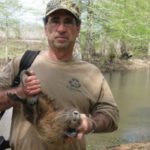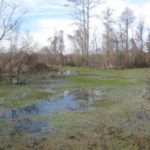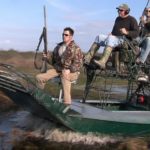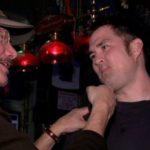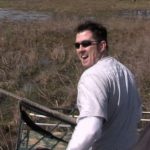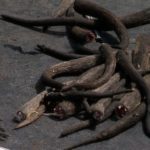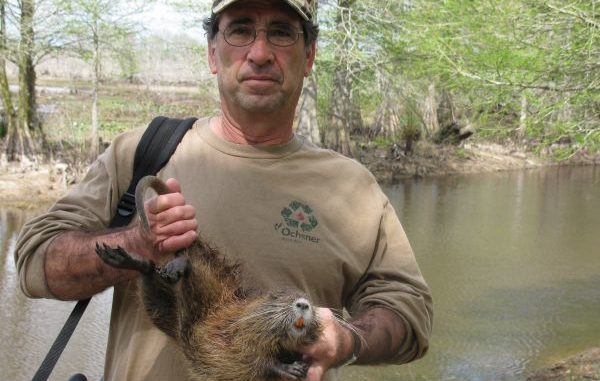
Nutria damage thousands of acres of Louisiana’s fragile coastal marshes each year, and here’s how you can help minimize that damage — one rodent at a time.
“The coyotes ate all the rabbits! The ducks got short-stopped! And the squirrels all live in woods leased by deer clubs who hate squirrel hunters! So how’s a kid supposed to scratch his hunting itch nowadays?”
Artie was in another of his moods at Doc’s camp.
“Oh, I don’t really mean hunting itch,” he continued after a hearty swig and a thunderous belch. “I mean blasting and killing itch. Oh, I know, I know. It’s not really ‘blasting and killing;’ it’s ‘harvesting,”’ he added with a smirk. “And I know, I know: It’s not all about the shooting. It’s about ‘the camaraderie, about learning sportsmanship and conservation principles, about watching the beautiful sunrise, the pretty roseate spoonbills, about blah, blah, blah.’ Sure — sure.
“Call it whatever you like. Point is while hunting we all want action. And the younger we are the more we require. By action I mean blasting and killing. And that’s exactly what we’re gonna be doing on our nutria hunt — and not just the kids.”
“Can I get you another brewskie?” Pelayo asked Artie as he headed toward the keg. Then he turned to us winking. “The boy’s on a roll! Let’s fuel him up and keep him going!”
Meanwhile, over in the corner, Spencer — looking spiffy in his DU pullover — grimaced, curled his lips and rolled his eyes at Artie’s monologue.
“Just great,” he growled as he walked toward Pelayo with a disgusted look. “Just great. Here’s Artie celebrating shooting stuff just for the fun of it — just great! Really, Artie? I mean, you set a fine example for our sport, Artie! You’re the kinda guys who give PETA all the ammo against us. You guys go out there — and get your yahoo jollies just shooting stuff for the heck of it! Just great!”
Every year lately Spencer and his spiffy (and sanctimonious) little clique embark on one of those “hunting” junkets to Argentina. They pile up doves, pigeons and ducks by the hundreds. Three shotguns are needed to keep barrels from melting (almost literally) from the constant shooting.
All birds are donated to the hapless natives. Guides locate the flyways, set up the blinds (in a word: do all the genuine hunting.) The guides and their families retrieve, clean, cook and eat most of the kill.
But apparently “shooting stuff just for the fun of it,” plays no role in Spencer’s (and his sanctimonious little clique’s) “hunts.”
Nutria hunting is fun for sure, but the shooting fun is not really the be-all and end-all for the mega-generous nutria season extended by the LDWF lately.
To wit: Normally nutria season would close with the rabbit season at the end of February. But starting last year, the Salvador, Timken, Point-aux-Chenes, Atchafalaya Delta and Pass a Loutre WMAs (the best for nutria hunting) have extended their nutria-hunting season until the end of March.
A Louisiana trapper’s license ($25 and available at all regular hunting- and fishing-license outlets) is all that’s required.
These fresher marshes — like the ones in upper Terrebonne, St. Charles, Lafourche, St. Mary parishes in the Salvador area — provide the best nutria hunting anyway. By February and March most of the higher shrubs are freeze-burnt, shriveled and flat.
The nutrias stick out pretty easily.
Normally we merely walk the ridges and shooting the bull and the occasional nutria. Our nutria hunting is a gregarious sport. Instead of texting each other as we did for three months from deer stands while bored out of our gourds, while nutria hunting we actually talk to each other — face to face, if you can imagine such an oddity.
You don’t need dogs to flush this game out of the brambles, or spotting scopes to spot them. You merely walk around looking for that little brown clump or clumps, take aim — POP!
This trapper’s license, by the way, also extends the nutria season on private land until March 30. And here’s where some serious fun really kicks in: On private land the landowner and his lessees and chums can now use “any means” to take nutria from the end of February until then end of August.
This means blasting them from moving boats — from airboats, mudboats, surface drives — even bull-eyeing at night.
The state’s official nutria control program that pays a $5 bounty per nutria tail also looks like a resounding success. Last year 388,160 tails were turned in by 394 participants, compared to the 97,271 tails when the program kicked off in 2002.
The proof of success was how wetland damage went from 82,080 acres in 2002 to 4,624 acres last year. You don’t see many government programs showing similar success, that’s for sure.
Nutria damage to wetlands was explained in great detail during Marcus Luttrell’s Outdoor Channel show titled “Wild and Raw” a couple of years ago. This episode involved a visit to South Louisiana, and featured an approach to nutria very similar to Navy SEAL Luttrell’s approach to the Taliban back in 2005.
Luttrell, in case you haven’t been to the movies lately, is the inspiration for America’s hottest movie of the moment Lone Survivor, based on his bestselling book of the same title. In brief he was the sole survivor of his four-man Navy SEAL team that fought off 150 Taliban warriors in Afghanistan’s Hindu Kush mountains in 2005, killing over half of them. Luttrell received the Navy Cross (pinned by President Bush himself) and Purple Heart for his actions. His action-packed and ultra-realistic movie has audiences and — amazingly enough for a patriotic movie — even the critics raving!
Right after Luttrell had signed his movie deal, his Outdoor Channel show invited your humble servant to partake of a “Wild & Raw” hunt with the hero — a pronghorn antelope hunt, that is.
“Ummm …?” I responded. “Did you say the show’s titled ‘Wild and Raw?’ Well, howze about instead y’all come down to South Louisiana and we live up to the show’s title?”
I also explained in excruciating detail how we’d be selflessly devoting ourselves to a purely altruistic endeavor immensely beneficial to our wetlands, and thus our environment, and hence the brotherhood of mankind in general, overshadowed as it is in these harrowing times by the looming cataclysm of global warming.
I explained the wetland damage wrought by the hordes of nutria that infest South Louisiana, how the state had even put a price on their heads (tails, actually) in the form of a bounty. How these huge rodents eat 25 percent of their weight a day in marsh grasses. And how they especially like the roots, which results in those bald patches, those “eat-outs” we’d see in the marsh.
“Nutria,” I gasped, “can munch through almost 100,000 acres of valuable Louisiana wetlands every year!”
As luck would have it, the hunt coincided with Mardi Gras season.
“Marcus’ show is titled ‘Wild & Raw’ right?” I asked. “Well, it can’t get much wilder and rawer than what I plan for the show!”
As befits a guy who devotes most of his book (and much of his movie) to his departed Navy SEAL brothers, and who treasures his Texas roots and upbringing and the lifelong friendships forged in this setting, when Marcus learned he’d have an (expense paid) weekend in New Orleans for Mardi Gras, he realized he had no choice but to invite a bunch of his high school chums to share the festivities.
“That means,” I continued, explaining to the show’s cast and producers, “that we’ll engage in two days of the kind of wildness and rawness that would get us thrown in jail anyplace in America — except South Louisiana. We’ll be guzzling booze from open containers on public streets, the whole while ogling gals clothed only in body paint — if that!
“Next morning we’ll be blasting marshland creatures to our hearts’ content without regard to limits and from moving (almost airborne, in fact) boats! I repeat, anyplace else in America, any such ‘Wildness and Rawness’ would land us all in the slammer! Look, I had nothing to do with picking the name for Marcus’ show, obviously. But down here we’ll certainly do the name some justice!”
And so the plans were set in motion.
Marcus and his high school chums were clearly enjoying themselves on that Bourbon Street balcony Mardi Gras night when I blurted: “Bet you had no idea saving the environment could be half this much fun, huh?”
Next morning came a different kind of fun, which really doesn’t require much of a technical how-to description.
We loaded up .22 semi-autos and shotguns, cranked up the airboats and roared out over the flotant marshes south of Gibson and Bayou Black. You could see the little brown lumps all over the landscape.
As we approached they’d start running — then we’d start blasting — and blasting — and blasting — and blasting.
All that whooping and high-fiving! All those smiling faces, the guffaws! You simply can’t get away with that even on the Outdoor Channel nowadays without injecting a quasi-enviro rationale for all the blasting fun.
So for a few seconds of the show we affected somber faces, tried to hide the tongues in our cheeks and went greenie with a mini-sermon on our purely altruistic behavior that morning.
Luttrell put as bad a hammering on the nutria as he had on the Taliban. What a privilege to make his acquaintance. What a thrill to hear — first hand — some details of his freedom fight in Afghanistan. And what an honor to share a hunt with this Navy SEAL and towering American hero.
Now, when it comes to hunting them on WMAs or private land without airboats, it’s a slightly different matter.
You get a little more exercise and a little less shooting, as we made good on Artie’s promise to his nephews.
Artie himself, as usual, bugged out at the last minute. (“Had to prepare his Endymion costume and throws,” or something like that.)
We were walking the semi-firm marsh (watch those flotants!) below Des Allemands when Artie’s 14-year-old nephew Tommy suddenly hunkered down and his face lit up.
Cats get this look, too, when eyeing that blue jay at the bird feeder. He looked over and smiled wickedly. His cousin Blake returned the look. They were in rapture. Two predators closing on prey. Nothing gets the predatory juices flowing like stalking.
Closing on unsuspecting prey is what really lights the predatory fire. Sadly, they didn’t get much of this during their deer hunts from box stands, time during which they spent mostly fidgeting and texting.
Their excitement was contagious. Pelayo and I were catching it — shades of our own (genuine!) “youth hunts!” Not sitting in some blind or stand — but roaming and blasting, roaming and blasting.
We hung back, watching the kids as they closed the distance on a group of three rats soaking up the midday sun at the base of the spoil bank.
The boys crouched lower, lower, almost on hands and knees now, and taking advantage of a little clump of wax myrtles for cover as they closed the distance to their hapless, unsuspecting prey.
The boys worked as a team, Tommy with his scoped .22 and Blake with his 20-gauge pump (steel shot required). They were about 30 yards out when Tommy kneeled and took aim; Blake stood at the ready behind him.
“Come on!” Pelayo hissed. “Shoot!”
But Tommy was making sure. The boy insists on head shots” Pop!
And one nutria keeled over, his legs twitching in the air.
The other two bolted off, and that’s when Blake sprang into action, running up a few feet over the flotant, raising the shotgun — blam! Shaw-wuck went the little pump — blam!
The nutria flipped.
Blam! The third nutria slowed down as the shot raked its back.
Pop! Tommy finished him off with a bullet through the boiler room.
Now the boys were running over, stumbling in their hip boots.
Ten minutes later they jumped two more from a patch of elephant ears near the shore of a pond. The nutrias immediately hit the water and dove.
“Let’s wait a bit guys.” I suggested. “Those nutrias might come back.”
And we sat a log for drinks, sandwiches and chips.
In about five minutes Tommy pointed. “Hey! Is that ….?’
Sure was. The nutria had popped up about 80 yards from shore and were starting to swim back.
We hunkered down again in the surrounding bushes. In they came in — closer — closer. I looked over and had to stifle a laugh. Those faces again — those alert, excited predator faces. Here’s some genuine hunting, some hunting to wrench a kid from the most action-packed video game.
And, oh, nutria are also delicious — as acknowledged lately by everyone from Anthony Bourdain to Paul Prudhomme.
To avoid all those guts, I don’t bother gutting nutria. I simply lay them belly down on the cleaning table and cut the skin down from the neck along the backbone to the tail.
Then I peel the skin open, pull out the front legs and clip them off with heavy garden shears at the feet and shoulder. Then I fillet off the backstrap and continue to the back legs, where I again pull them away from the skin, clip at the feet and clip at the pelvis.
Nothing to it.
Taste like chicken? Not really. More like domestic rabbit.
